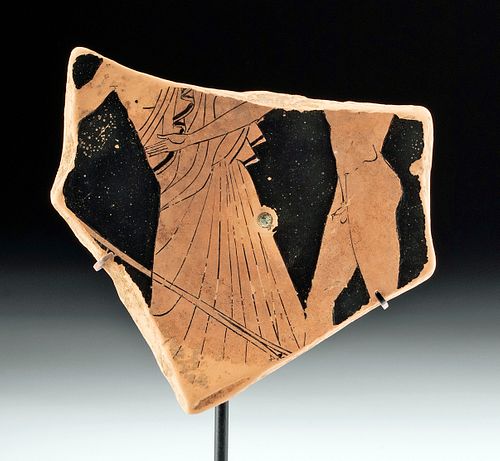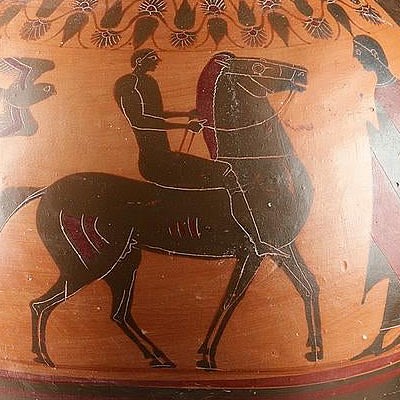Attic Red Figure Kylix Fragment - Douris Painter
Lot 21b
About Seller
Artemis Gallery
686 S Taylor Ave, Ste 106
Louisville, CO 80027
United States
Selling antiquities, ancient and ethnographic art online since 1993, Artemis Gallery specializes in Classical Antiquities (Egyptian, Greek, Roman, Near Eastern), Asian, Pre-Columbian, African / Tribal / Oceanographic art. Our extensive inventory includes pottery, stone, metal, wood, glass and textil...Read more
Categories
Estimate:
$2,500 - $5,000
Absentee vs Live bid
Two ways to bid:
- Leave a max absentee bid and the platform will bid on your behalf up to your maximum bid during the live auction.
- Bid live during the auction and your bids will be submitted real-time to the auctioneer.
Bid Increments
| Price | Bid Increment |
|---|---|
| $0 | $25 |
| $300 | $50 |
| $1,000 | $100 |
| $2,000 | $250 |
| $5,000 | $500 |
| $10,000 | $1,000 |
| $20,000 | $2,500 |
| $50,000 | $5,000 |
| $100,000 | $10,000 |
| $200,000 | $20,000 |
About Auction
By Artemis Gallery
Jun 4, 2020
Set Reminder
2020-06-04 10:00:00
2020-06-04 10:00:00
America/New_York
Bidsquare
Bidsquare : Exceptional Antiquities, Asian, Ethnographic
https://www.bidsquare.com/auctions/artemis-gallery/exceptional-antiquities-asian-ethnographic-5185
An important one-day auction featuring museum-worthy examples of Egyptian, Greek, Roman, Etruscan, Near Eastern, Far East / Asian, Pre-Columbian, African / Tribal, Oceanic, Native American, Spanish Colonial, Russian, Fossils, Ancient Jewelry, Fine Art, so much more! Artemis Gallery info@artemisgallery.com
An important one-day auction featuring museum-worthy examples of Egyptian, Greek, Roman, Etruscan, Near Eastern, Far East / Asian, Pre-Columbian, African / Tribal, Oceanic, Native American, Spanish Colonial, Russian, Fossils, Ancient Jewelry, Fine Art, so much more! Artemis Gallery info@artemisgallery.com
- Lot Description
Ancient Greece, Athens (Attic), attributed to the Douris Painter, ca. 480 to 470 BCE. An Attic red-figure kylix fragment, depicting two figures, one draped in a flowing garment and appearing to face forward and the other a nude male in profile with an erect penis. This piece has been attributed to the Douris Painter. For more about the Douris Painter, see the biographical statement from the J. Paul Getty Museum in the extended description below. Size: 3.35" W x 3.3" H (8.5 cm x 8.4 cm); 4.55" H (11.6 cm) on included custom stand.
According to the Getty Museum, "One of the most prolific vase-painters known, Douris worked as a vase-painter and occasionally as a potter in Athens in the early 400s B.C. He is known from almost forty signed vases, two of which he also potted. Altogether, almost three hundred vases have been attributed to him. Given that scholars estimate a less than 0.5% survival rate for Greek vases, Douris may have decorated about 78,000 vases in his career. Douris primarily decorated red-figure cups, but he also painted a few vessels of other forms and in other techniques, including white-ground. His scenes are about evenly divided between mythology and depictions of everyday life. He worked with a number of potters, including Kleophrades and Euphronios, but he seems to have had a regular collaboration with Python. Onesimos depicted a cup signed by Douris on one of his vases, and there is even an ancient forgery of Douris's signature. These unusual references attest to Douris's significant influence among contemporary vase-painters."
Provenance: private Connecticut, USA collection; ex F. Schultz collection, New York, USA, early 1980s; ex A.S. Richter collection, California, USA
All items legal to buy/sell under U.S. Statute covering cultural patrimony Code 2600, CHAPTER 14, and are guaranteed to be as described or your money back.
A Certificate of Authenticity will accompany all winning bids.
We ship worldwide and handle all shipping in-house for your convenience.
#155930Piece is a fragment with the edges lightly smoothed. A small, regular opening at the center has been filled in with white material as shown. Great preservation of motifs with very light abrasion and wear, mainly on the reverse.Condition
- Shipping Info
-
All shipping is handled in-house for your convenience. Your invoice from Artemis Gallery will include shipping calculation instructions. If in doubt, please inquire BEFORE bidding for estimated shipping costs for individual items.
-
- Buyer's Premium



 EUR
EUR CAD
CAD AUD
AUD GBP
GBP MXN
MXN HKD
HKD CNY
CNY MYR
MYR SEK
SEK SGD
SGD CHF
CHF THB
THB













